#Niigata destinations
Text
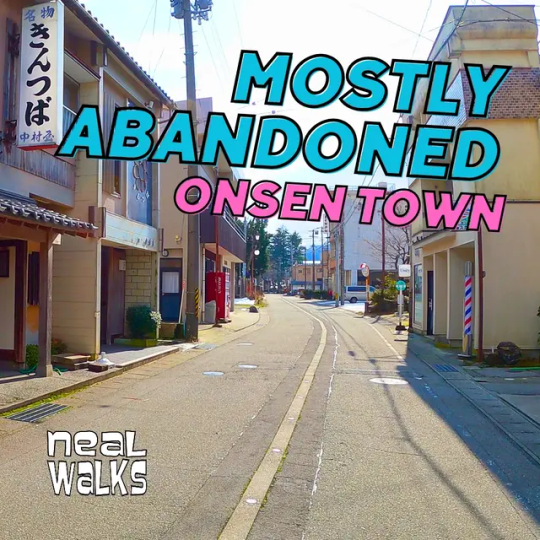
Mostly Abandoned Onsen Town in Japan
Watch the video:
https://youtu.be/1x12OUWGtWk
Join me on a sunny-day stroll through the nearly forgotten Takase Onsen in Sekikawa Village, nestled in a mountainous corner of Niigata Prefecture, Japan. The weather couldn’t have been more perfect for an early February day! During my walk, I stumbled upon several old and abandoned onsen hotels. This street has clearly seen better days. There's not much happening here anymore. I'm not sure how much longer the remaining businesses will be around.
Subscribe and follow:
https://www.YouTube.com/@nealgraham
https://www.instagram.com/thenealgraham/
https://www.instagram.com/neal.walks/
#japan#niigata#youtube#japan destinations#japan travel#walk in japan#japanese onsen#hot spring#abandoned
2 notes
·
View notes
Text

LIVING IN A WINTER WONDERLAND ♡ NANAMI KENTO
nanami kento x gn!reader
ingredients? tired and cold from a christmas season mission, nanami and you come to your hotel room to discover a single bed at the center.
what's it? general. a sprinkle of fluff
allergen warning/s? gojo being a nosy prick
sugar level? 1.8k
regulars? @tokyometronetwork @tahonet
parlor's note? i've seen so many oh-no-there's-only-one-bed fics with gojo, but none for nanami, so here's my present for my nanami hoes <33
happy holidays everyone!
bon appetit!

when the two of you finally managed to exorcise the special grade curse and retrieve yet another one of ryomen sukuna's fingers from it, the blonde man heaves a sigh of relief for more reasons than one.
it's heavily snowing in tsunan in the niigata prefecture, the temperature in the negatives. just his luck to be dispatched to one of the snowiest places in the world, during christmas too, no less.
a chill ran through nanami's whole body, and it had nothing to do with the adrenaline in his veins. he even swears it has nothing to do with the fact that he was dispatched with you on this particular mission, but rather how cold it was. his whole face was flushed pink, from his chiseled cheeks, the tip of his nose, all the way up to the top of his ears. his teeth were chattering slightly, and if one were to focus on him, they'd see how his figure shivered.
followed by the sigh was a sneeze and a sniffle which made you smile lightly and tilt your head to the side at him, "guess we'd better go back to the hotel, huh, big guy?"
big guy, he grimaced internally. that sounds worse than nanamin, and when someone gives a nickname more annoying that the ones gojo satoru gives, you know it's bad. however, nanami doesn't have it in him to complain about it; he curtly nods. "yes, i believe that's the best way to avoid getting sick in this weather."
the curse attacked the both of you prior to you getting checked into your hotel, so you picked up your bags from wherever you were able to throw it earlier before hailing a taxi cab. "you sure you got everything, nanami?" you asked him as you began putting your luggage into the trunk, and as he did the same with his, he answered you. "yes, i'm sure. i made sure to pack light since were aren't staying here for long anyway. what about you, [l/n]-san?"
"nanami! i told you that you don't have to be so formal with me! my first name's fine." you waved it off, "but yeah, i have everything too. thanks for asking!" you beamed at him.
the cab ride from the old, abandoned building to the hotel was short. perhaps just a bit below ten minutes, but it was filled with chatter from the old driver. at first he wondered why the two of you were out so late, and at the aged hospital that no one has used for the last ten years as well, nonetheless. nanami, sat at the passenger seat was able to quickly and smoothly make up a lie, and from there, started to make some small talk which evolved to the male driver telling crazy passengers he had driven in the past. the stories ranged from three gaijin wrestlers filming for their vlog, to drunk celebrities, to high schoolers singing along to the seventies music that his favorite radio station played -- he expressed that the last one was more surprising than being on the crazy side of things.
but alas, your fruitful interaction had to be cut short when you've finally reached your destination. nanami just let the man finish his last story, before paying for the cab ride and getting out of the vehicle.
thankfully for the both of you, the hotel, as expected, was much, much, much warmer than the outside world. nanami let out a sigh of relief at the warmth when he step foot into the establishment, then made a beeline towards the front desk. he was worn out and tired the same way you were. number two on his wishlist was to be somewhere warm, and now that he has received that, it was time for the close third; rest and as well as a comfortable bed.
just as nanami turned around to see if you were still behind him, your phone unexpectedly rang. you lifted a quick finger at him as you fished it out of your pocket to answer. the device's caller id identified it as gojo making you roll your eyes. while you did count the man as one of your friends; being a sorcerer makes you feel some sort of connection to people who are in the same boat as you, no matter how annoying they are, and annoying gojo satoru was. going against your better judgement, you swiped your thumb across the screen to answer the call and pressed the cool material to your ear only to hear the white haired sorcerer greeting you with a voice that's too cheery for half past ten in the evening.
"moshi moshi [y/n]-chan~" he spoke through the line. "are my precious underclassmen safe and sound yet or do they need my help?"
and for the second time, you rolled your eyes. "hey gojo-san, me and nanami arrived at the hotel a few minutes ago. we're going to our rooms now." you informed him as nanami gestured that he already has the room keys and that you could already proceed to the elevators to get some much needed sleep.
"hmm, and is it as cold there as the news make it out to be?" he asks in a sing song voice, clearly entertained at your expense.
"yes. yes it is." you refused to give him a reaction you know he'll tease you with and opted to keep the conversation as short as possible. "do you have anything of substance to say, gojo-san? or can i hang up now. me and nanami are tired."
you heard him chuckle on the other end of the line. "nada, [y/n]-san. hope you enjoy your night with nanamin." there's a teasing tilt to the end of his goodbye that made you wish you never went out drinking with him because what happened was you were the only one that drank as he wasn't good at handling his alcohol. you didn't remember much of what happened that night, but when gojo enunciated the blond man's name every time he spoke it the next day, you knew you opened your mouth and spoke too much around gojo.
the elevator ride and the walk to your shared hotel room was quiet and uneventful. neither you nor nanami felt the need to plug up the comfortable silence with uncomfortable small talk. the time you uttered words to each other was when he pushed the door to the room open. "what the fuck?"
one bed.
at the center of the room, there was a single bed. it could fit two people, you're sure of that, but that didn't change the fact that there was one bed when there was supposed to be two.
staying in the same hotel room with nanami was enough to set your soul on fire by itself. sleeping in the same bed as him? you're certain you might melt into a puddle on the floor that nanami would hate to clean up.
"i knew it was a mistake trusting that dimwit." you heard the man next to you mutter, so you turned your head towards him for some sort of explanation because you were at a loss.
he looked at you, before looking away quickly as if in guilt or something else. you couldn't tell. "i may have asked gojo to handle our hotel reservations."
your eyes widened at once, a scream was building up your throat, you could feel it. the hot air from your lungs was slowly rising up, up, up, fueled by tension until it was in your mouth, "i'm sorry, you did what?" you screeched, but nanami had quick reflexes and pressed a hand on your mouth at once to muffle your words. "i apologize, [l/n]-san. i was busy at the time and didn't realize he would stoop this low."
you inhaled a deep breath and pried his hand off of your face. "'t's fine, nanami. i guess we all make mistakes sometimes." you shrugged at him, putting your luggage down and going through it to fetch a shirt that's two sizes too big for you as well as pajama pants. "it's real late," you glanced up at the clock, "i doubt we can get another room, and kicking up a fuss about this more than i already have is pointless." you told him. "lemme just take a quick shower, then the bathroom's all yours, yeah?"
normally, you would have asked him if he wanted to go first, but tonight, you deeply needed to gather yourself since your heart's already pounding out of your chest at the mere thought of spending the night laying in the same bed as him.
with a small bow, you walked past him and into the bathroom.
the hot water definitely did you some good, and so does the music you're listening to right now. you're able to keep calm laying in the neat white sheets with your eyes shut tight. when you hear a door open and close, you keep it that way, not wanting to break your concentration. however, that was impossible.
a clearing of the throat was heard, followed by a deep raspy voice. "[l/n]-san, the best course of action for tonight would be for me to sleep on the couch." your eyes snapped open and you sat up via their own accord. "i don't want to make you uncomfortable, and besides, this was my mistake. i am not going to burden you."
"it wouldn't be a burden!" you answer too fast. you shrank into the sheets in embarrassment. "i meant, we're both adults, nanami. i trust you. us sleeping in the same bed wouldn't make me uncomfortable. you don't have to worry about that.” you waved it off.
he raised an eyebrow, "and you're being honest? i don't want this to be another case of you being too polite." he started walking towards the bed as you nodded. "i'm sure nanami, it's perfectly fine with me, as long as it's perfectly fine with you.
he wasted no time after that, lifting the covers on the side you weren't on and shuffling into it. "thank you [l/n-san, i mean it. i was afraid that laying on the couch would hurt my back." he confessed making you laugh. "of course, nanami-san. you've never done anything to make me feel unsafe around you. let's have a good night's sleep, yes?"
the following morning, nanami found himself in a very unfamiliar position: him on his side with you snuggled in his chest, longing to absorb all the body heat from him that you could muster. and he has wintertime and gojo satoru of all things to thank for him being able to check off number one in his wishlist.

i get: reblog
you get: a prosperous new year
#order of the day!#order up for nanami!#one matcha mochi#with a side of coconut italian ice#with a side of peach italian ice#nanami#nanami x reader#nanami x you#nanami one shot#nanami fluff#nanami kento#nanami kento x reader#nanami kento x you#nanami kento one shot#nanami kento fluff#kento nanami#kento nanami x reader#kento nanami x you#kento nanami one shot#kento nanami fluff
229 notes
·
View notes
Text
Hyper-obscure promotional collaborations in PPTP S2
I've grown really fond of season two's new gimmick of official in-show ads for prefectural shops and destinations
Apollon (music store, 6 locations in Niigata)


Washuzan Highland (amusement park in Okayama which is where bkub is from now that I think of it actually)
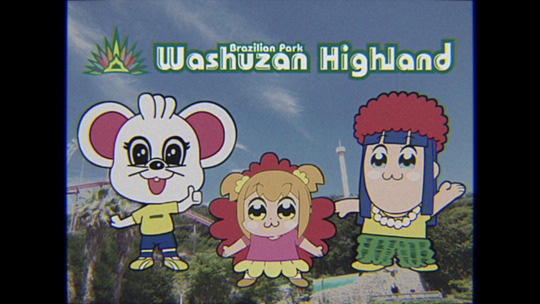
Kappa Sushi (nationwide chain)


And my favorite really weird one, SunPole... which is not an indie anime studio like I first thought, but rather Japan's leading manufacturer of flagpoles and traffic rails for public spaces.


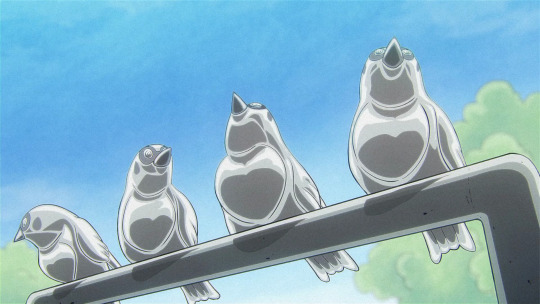
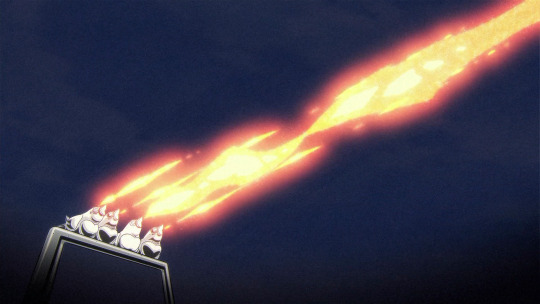

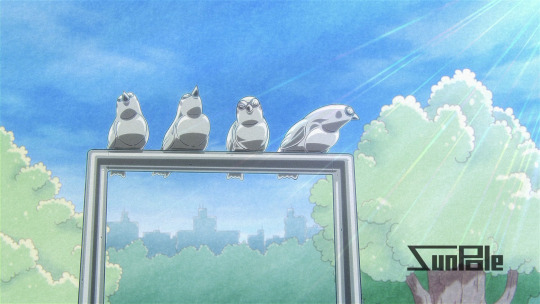
This model is cutely named "Piccolino," and it is designed for placement in playgrounds. SunPole also makes a version called "KAERU," which features a frog ornament. Here's what they look like on SunPole's website:
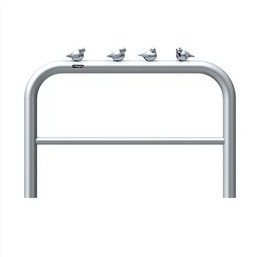

81 notes
·
View notes
Text
Where is Etsusa Bridge, anyways?
(all quotes are from @untuned-strings' translation)
Warning: excess amount of pictures and my decreasing sanity about this project
The longest bridge in the world, standing between Sado and Niigata. The nameless artificial island in the very middle of the bridge, abandoned in the recession, is a lawless world swarming with illegal immigrants and criminals — a modern-day Kowloon Walled City.
Okay so. Where is it? Well, where would it be, that is. We know Etsusa Bridge doesn't actually exist, but let's see if we can pin down where the actual location is. We know the bridge connects Sado and Niigata. That's a good step one.

Obviously the sensible thing would be to connect at the shortest possible destination right. Well nothing is sensible about this project, to be fair.
The next thing we know - when we first meet Hayato, he is at the Rainbow Tower.
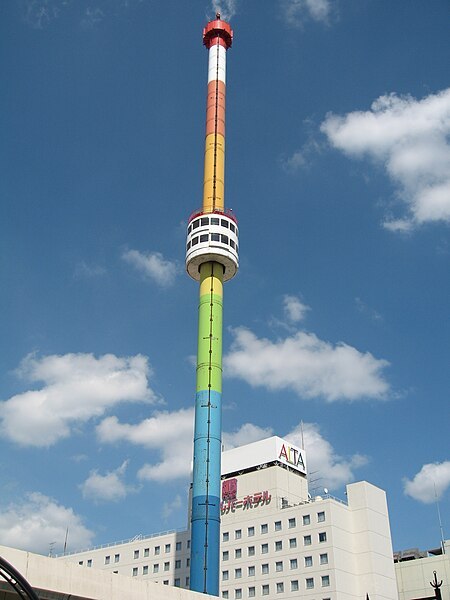
Which is fitting for our rainbow-headed bastardboy, but we couldn't replicate it even if we wanted to, as the tower had gotten demolished in 2018. As Hayato visited the Rainbow Tower in 2014, he squeezed in just in time (although by the time he left the island in Bow Wow in 2019, the Rainbow Tower would have been gone)
Rainbow Tower's location:
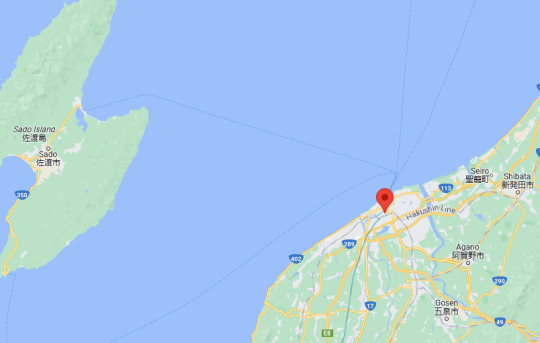
That said Hayato gets up there, to the 100-meter-high observation point explicitly to look at the bridge.
“Ah! There, there. I see it. Heh. To be honest, I came just to see that thing over there.” He said to the silent family in a subtly affable voice.
The structure at the end of his gaze was the monstrous bridge that connected Sado to the mainland, and the massive artificial island in the middle. Rainbow-Head pressed his face to the glass, mumbling to himself.
I think this means that this is still quite far from that specific location - it's easier to get there via plane or whatever he used to get back to Japan from South America, so he'd climb up there just to eye up his next destination. I don't think they built it close to the tower because...

You see? Not very sensible.
At this point you can probably pinpoint the area I am eyeing. After all, very clear where the closest points are right? Right?
"G, the entire project was just a vanity project because they wanted to outdo China" yes yes yes, but I like to think there were SOME sensible people on this project, okay?
Let's see if we can get anything else
Like... where did Seiichi come from? After all, Hayato came from the Niigata side, Seiichi came from the Sado side.
Seiichi and Kanae's section starts with the Himezaki Lighthouse

....bro.

BRO!!!!
This is the part in my research I start to feel like going mad. Because. While with Hayato I could easily argue that maybe he traveled to the area where the two islands are closest to each other - he's a grown man, and sure, he doesn't have money, but when did that ever stop him? I can reason it with Hayato. But Seiichi and Kanae are fifteen, and yes, we know he had done big adventures before... somehow I doubt so. But let's keep reading.
“I found a little gap we could squeeze through to Etsusa Bridge!”
“What?”
He recalled the crude building jutting off the southern edge of the island. Etsusa Bridge had the biggest presence on the island, but it was not particularly associated with the function of a bridge. After all, he had never crossed the bridge—in fact, he had never even gone near it.
...yeah no, if Kanae could alone wander around to find that gap, it has to be close to where they are. And even Seiichi can recall where the entrance of the bridge is, even though he never really went close to it... it has to be close to them. And we can easily assume they live close to the lighthouse... why the hell would they build the bridge there?
Well... the traffic would explain it. Because see, if you'd want to get from where the Rainbow Tower had been and go to Sado Island today...

Look where the ferry goes. Sure the Bridge cannot be built to go to Ryotsuko Sado Kisen because THAT would actually be a hell of a construction job. But the Himezaki Lighthouse is a good-ish spot.
Let's keep going. We know where Seiichi and Kanae enter. Where does Hayato get on his ride there?
Niigata harbor. Which is pretty much the area where you have to board the official ferry to Sado Island too. So yep.
So. We can pretty much guess the location now.
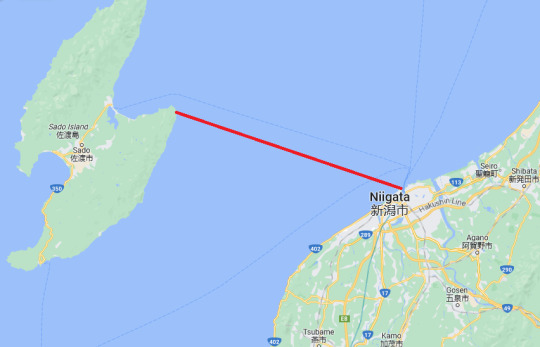
Or maybe
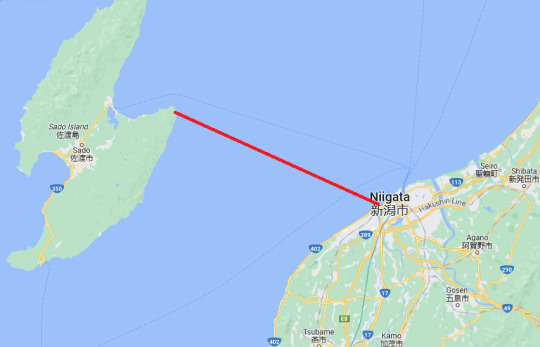
Let's see if we can guess based on length.
Hayato's guide to the island mentions that the longest over-sea bridge in China is "35, 36 km" and that Japan wanted to beat that record. The bridge they are talking about is Hangzhou Bay Bridge. Which is, in fact, 35,6 km long. So we know Etsusa Bridge has to be longer. Let's see the distances.


So around 42-45 km. Aight. I am choosing to ignore the part where Seiichi says as far as he knows, the island is about 10 km off from Sado because then I'll have a meltdown about the island's placement and how big is the artificial island supposed to be, jesus christ.
I mean. It is described as a "kilometers-long fortress", so take it as you will.
At the end of Bow-Wow Hayato does escape to Sado Island - and then travels back to Niigata with a ferry (although with a very optimistic description from Narita as the ferry that Hayato uses to cross to the mainland goes way quicker than the one that Google Maps informed me of).
And the ferry did pass by the center of Etsusa Bridge, so... assuming this super fast ferry goes by the same route... the first option seems most likely

What a goddamned mess. What a giant project and for what? Sure, a lot of traffic goes through there.
The shortest distance between the two islands I found is about 32-33 km.
That wouldn't work for a vanity project now, would it?
I'm not going to try to figure out the actual size and placement of the island. Seiichi says it is around 10 km away from Sado Island. I'm sure you could calculate how big would it have to be and where it would need to be placed in order for the Bridge to be stable but I already went insane. I thought this was at least somewhat sensible of a project. But no. No it wasn't. LOOK AT HOW MUCH LONGER IT IS THAN THE SHORTEST DISTANCE BETWEEN THE ISLANDS. Goddamnit.
@agallimaufryofoddments tagging you too because I feel like you might be interested in my insanity.
5 notes
·
View notes
Text
A3! Translation - Regional Tour Instablam Posts (Autumn Troupe)
Autumn was a little easier to do than Winter was... you’ll probably see why pretty quickly lol
Also, the like count on the posts seem to be completely random. This isn’t important to the meanings of the posts, but I think it’s really funny that I’ve gotten Kazu posts with 0 likes lol
Also you can see here that I tried to vary the way they type out their tags in terms of capitalization and stuff! That’s a purely stylistic choice on my part; there’s not much in the Japanese that implies for it to go either way
Sendai - Zunda shake

Banri
Sendai. A commemorative zunda.
#the fabled zunda
#delicious
Juza
Delicious.
Taichi
Sendai was fun! (≧▽≦)
We all
drank zunda ^^
#MANKAI Company
#Sendai
#We’ll come again
#Zunda
#Wasnt sure what station lunch to get (1)
Omi
Thanks for coming to our Sendai play run.
This is sweet and delicious.
#Sendai
Sakyo
Thank you for attending our Sendai play run.
Apparently this is famous.
Azami
#Sendai
#Thanks
#Zunda
--
Nagoya - Nagoya morning breakfast set

Banri
Nagoya morning.
#coffee
#as for the ogura
#just looking at it made me sick
Juza
Ogura bean paste.
Taichi
Morning! ( `ー ´)ノ
My tummy’s been full
all day~!
#MANKAI Company
#Nagoya
#Morning
#Ogura bean paste
Omi
Active since the morning. This is healthy.
#Nagoya
Sakyo
Thank you for coming to our Nagoya play run.
Speaking of Nagoya, this is morning. The early bird gets the worm, after all.
Azami
#Nagoya
#Morning
#Accompanying an elder
#Damn sleepy
--
Osaka - Glico Running Man in Dotonbori (2)

Banri
Dotonbori.
#THE pose
#they forced me to do a pic
#not posting it tho
Juza
My souvenir from Osaka was a cheesecake.
Taichi
Osaka was fun! I luv it! (3)
Jk (≧▽≦)
I ate myself to death (4) with delicious food!
#Osaka #Surprise Kansai dialect #The hells with that (5) #Dotonbori #Variety #Ate too much #MANKAI Company
Omi
A food binge tour with everyone. When you think Osaka, you think food.
#Osaka
#Thanks
Sakyo
Thank you for coming to our Osaka play run.
As always, there were many people.
Azami
#Osaka
#Good work
#Dotonbori
#Sightseeing
--
Niigata - Red snow crab

Banri
Niigata crab.
#sea of japan
#shellfish
#massive
Juza
Crab.
Taichi
Crab! So big! Super tasty! ^^
#MANKAI Company
#Crab
#Niigata ftw (6)
#Hype
Omi
We ate crab today.
The seafood from the Sea of Japan
is fresh.
#Niigata
Sakyo
Thank you for coming to our Niigata play run.
Of course the crab is good too, but the rice is delicious.
Azami
#Niigata
#Crab
#Impressive
--
Fukuoka - Tonkotsu ramen

Banri
When you go to Fukuoka you gotta have tonkotsu ramen.
#best place for it
#crispy style
#second noodle helping
#used it up
Juza
Ramen after the show run.
Taichi
Thanks Fukuoka~!
And my long-awaited tonkotsu ramen ^^
I enjoyed it all the way down to the soup!
#Fukuoka fun
#Hakata (7) tonkotsu
#ramen
#MANKAI Company
Omi
Enjoying Fukuoka. This is our last stop.
#Fukuoka
Sakyo
Thank you for coming to our Fukuoka play run.
At the end of the run.
Azami
#Fukuoka
#Tonkotsu ramen
#Light oil
#No overeating
#No ruining your skin
--
Notes:
1. This was 駅弁悩む (ekiben nayamu), which is literally “worry about the station bento,” but that sounded to me like he wasn’t sure if it would be good or not
2. Dotonbori is a popular tourist destination in Osaka! Food is huge in Dotonbori, and Osaka in general, which you’ll see in a lot of the posts about it.
The Running Man sign is an ad for Glico, the company responsible for Calpico/Calpis and Pocky! The ad has been up since 1935.
3. Taichi says 好きやねん (sukiyanen) here, which is Kansai dialect for “love it”. I normally don’t do anything funky with Kansai-ben, but if I didn’t it’d look like he was saying “I love Osaka. JK NO I DON’T” lmao so we had to do SOMETHING. Shoutout to Moonlight for the simple suggestion!
4. Here Taichi uses the phrase 食い倒れ (kuidaore), which basically means “eat til you drop. I had to change the TL a to “eat oneself to death” to make it sound ok, but it basically means the same thing, right?
Omi’s “food binge” is also originally 食い倒れ
5. The standard tsukkomi retort in manzai as well
6. This was 新潟最高 (Niigata saikou), with 最高 basically meaning “greatest.” I let myself have a little fun as a treat lol
7. Another name for Fukuoka
#a3!#autumn troupe#a3! translation#i think i've been mixing up 'a3! translation' and 'a3 translation'#i'm gonna have to fix the ones without the exclamation point#I'd like to try nagoya morning but I'm worried the ogura will be way too sweet for me#all in all the winter foods looked a little more appetizing to me lol#i've like half proof-read this so if i made a glaring error let me know
13 notes
·
View notes
Text
About Disaster Intensity Points (PDI)
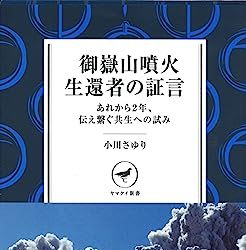
Japan is a country that is destined to face various disasters that easily threaten the lives of its citizens. Therefore, as an index for roughly evaluating the degree of disaster risk, PDI (Disaster Intensity Points: Points of
Introduce Disaster's Intensity).
(1)As a disaster
1. Typhoons (including tornadoes)
2. Earthquake (including fire and crushing)
3. tsunami
4. Volcanic eruption (including pyroclastic flow)
5. Torrential rain (including floods and debris flows)
6. heavy snowfall
7. thunderstorm
Set seven of
(2)All disasters are equal in the probability of causing fatalities.
(3)From the case where the risk of disaster is almost zero (0) to the case where there will be fatalities (1),
Evaluate the degree of risk of each disaster in increments of 0.1, sum over seven items, and make it the PDI.
In this trial calculation, we will use Morishita's guess, but if we study the past disaster history, we can get a more accurate value.
Accidents (melt downs) at nuclear power plants are: 2. earthquake and 3. Since it cannot be ignored as a secondary disaster in the case of a tsunami, the raw data is doubled for these two disasters. (If there is a nuclear power plant in the area.) So the PDI will be a value up to 9.
(4) This time, the trial calculations are made on a prefecture-by-prefecture basis, but more detailed divisions may be necessary or even possible.
The following is a trial calculation for the three prefectures.
Gunma Prefecture Niigata Prefecture Nagasaki Prefecture
1. Typhoon 0.2 0.2 0.8
2. Earthquake 0.2 0.8 0.5
3. Tsunami 0.0 0.8 0.8
4. Volcanic eruption 0.7 0.4 0.8
5. Torrential rain 0.2 0.6 0.8
6. Heavy snow 0.4 0.9 0.1
7. Thunderstorm 0.8 0.5 0.5
PDI 2.5 5.8 5.6
As a trend, PDI is low in inland prefectures without volcanoes, and conversely, in coastal prefectures with volcanoes.
It seems that the PDI will be high. Here, Nagasaki Prefecture does not have a nuclear power plant, but in view of the fact that there is a Genkai Nuclear Power Plant in Saga Prefecture, which is closely related to the neighboring prefecture, it is assumed that Nagasaki Prefecture also has a nuclear power plant.
Although Morishita regards "war" as a type of "disaster", it was not reflected in this PDI calculation. In addition, areas with many buildings that pose a problem due to the problem of disguised seismic strength naturally receive a high score for damage caused by an earthquake. In any case, modern “man-made disasters (man-made disasters)” are large in both quality and quantity.
#Disaster Intensity Points#PDI#disaster#rei morishita#Japan#Typhoon#Earthquake#Tsunami#Volcanic eruption#Torrential rain#Heavy snow#Thunderstorm
3 notes
·
View notes
Text
Top 5 Destinations for Spring Skiing in Japan

As winter fades away and cherry blossoms bloom across Japan, ski enthusiasts know that the excitement is far from over. Spring skiing in Japan offers a unique chance to glide through soft, sunlit slopes against stunning natural backdrops. While ski resorts in other parts of the world wind down, Japan's high-altitude slopes maintain excellent conditions well into spring. From the renowned powder haven of Niseko to the picturesque alpine villages of Hakuba, Japan offers a variety of destinations perfect for late-season skiing adventures. Let's explore the top five places where you can chase the spring snow and create unforgettable memories on the slopes.
1. Niseko
Nestled in Hokkaido's northern island, Niseko stands as Japan's premier ski destination, celebrated for its abundant snowfall and powdery terrain. With multiple ski areas within one expansive resort, Niseko offers an unparalleled skiing experience. Even as spring arrives, Niseko transforms into a haven for ski enthusiasts, offering extended ski seasons well into April and sometimes May. Its wide-open terrain, tree-lined runs, and off-piste possibilities cater to skiers and snowboarders of all levels. Moreover, Niseko's lively après-ski scene, luxurious accommodations, and top-notch amenities ensure a memorable experience both on and off the slopes.
2. Hakuba
Situated in Nagano's heart amidst the Japanese Alps, Hakuba Valley boasts a lineup of impressive ski resorts, each with its own charm and terrain. Thanks to its lofty elevations and north-facing slopes, Hakuba maintains excellent skiing conditions well into spring while other areas see the snow melting away. With interconnected resorts, Hakuba Valley offers endless opportunities to explore new runs and enjoy breathtaking views. Beyond skiing, Hakuba's blend of traditional Japanese culture and modern amenities promises an unforgettable spring skiing experience for enthusiasts of all ages.
3. Myoko
Located in Niigata Prefecture, Myoko emerges as a hidden gem among Japan's ski destinations, offering abundant snowfall and serene surroundings. Spring skiing in Myoko brings bluebird days, powder stashes, and fewer crowds compared to peak winter months. Its unique geography, marked by towering peaks and deep valleys, ensures optimal snow conditions well into April. Ski enthusiasts can traverse a variety of terrain, from groomed runs to challenging off-piste slopes, amidst Myoko's picturesque landscape. After a day on the slopes, visitors can relax in traditional hot springs or savor local delicacies in charming mountain villages.
4. Shiga Kogen
Located in Joshinetsu Kogen National Park, Shiga Kogen stands as Japan's largest interconnected ski area, offering over 600 hectares of skiable terrain spread across multiple resorts. Even as spring arrives, Shiga Kogen's high-altitude slopes maintain excellent snow quality, providing ideal conditions for skiing and snowboarding. With diverse terrain suitable for all skill levels, Shiga Kogen ensures an enjoyable experience for every visitor. Moreover, the area offers opportunities for outdoor adventures such as snowshoeing and wildlife spotting, making it an ideal destination for immersive mountain experiences.
5. Gassan
For a truly unique spring skiing experience, head to Gassan in Yamagata Prefecture, where skiing continues well into summer amidst breathtaking alpine scenery. Dubbed "the ski resort in the sky," Gassan boasts one of Japan's latest ski seasons, thanks to its high elevation and abundant snowfall. As other resorts close for the season, Gassan's slopes remain covered in pristine powder, offering a rare opportunity to ski against a backdrop of blooming cherry blossoms. Accessible via a scenic chairlift ride through lush forests, Gassan attracts adventurous skiers seeking an unforgettable spring skiing adventure.
In conclusion, Japan's spring skiing destinations offer pristine powder, stunning scenery, and cultural experiences for unforgettable adventures on the slopes. Whether you're carving through Niseko's legendary powder or exploring Hakuba Valley's expansive terrain, Japan's ski resorts provide ample opportunities for late-season skiing enjoyment. Consider venturing to Shiga Kogen for diverse terrain or experiencing the unique charm of skiing amidst cherry blossoms in Gassan. With optimal snow conditions and vibrant après-ski scenes, Japan promises a spring skiing adventure like no other. So pack your gear and embark on a memorable journey to the Land of the Rising Sun.
0 notes
Text
New Year’s in Niigata City: Celebrate at Hakusan Shrine
Okay, I recognize that this is very, very late, but I wanted to write about New Year’s in Niigata City before I leave at the end of this year. As I mentioned in my New Year's post last year, New Year’s in Japan is focused more on the first few days of the year rather than the night before as it often is in the US. However, that doesn’t mean there isn’t stuff to do on New Year’s Eve in Niigata City. It just might not be as big of a party as in the US.

I can’t talk about New Year’s in Niigata City without bringing up Hakusan Shrine. Hakusan shrine is one of the most famous shrines in Niigata City, which many people go to for New Year’s Eve for their hatsumode, or first prayer of the year. There are, of course, other shrines as well, including Yahiko Shrine and Gokoku Shrine, but Hakusan is somewhat close to Niigata Station, making it a popular destination. The shrine stays open through the night for people to visit and buy Omamori, or charms. While there wasn’t a cool lion dance or performance like there was at the shrine in Tokyo, there was a big fire to burn Omamori for purification and good luck. Plus, for 300 yen, you can fish for a New Year's fortune.
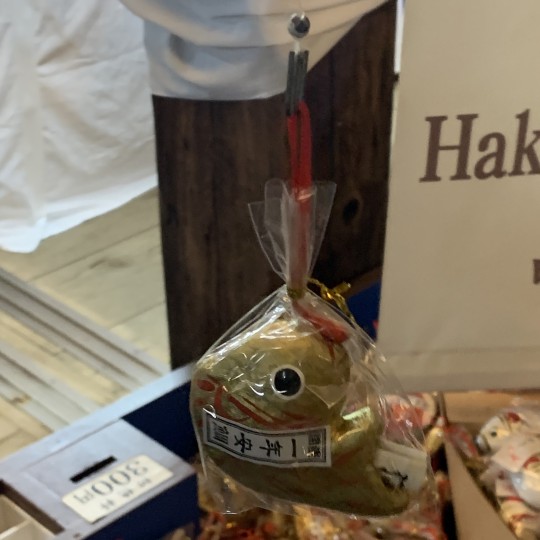
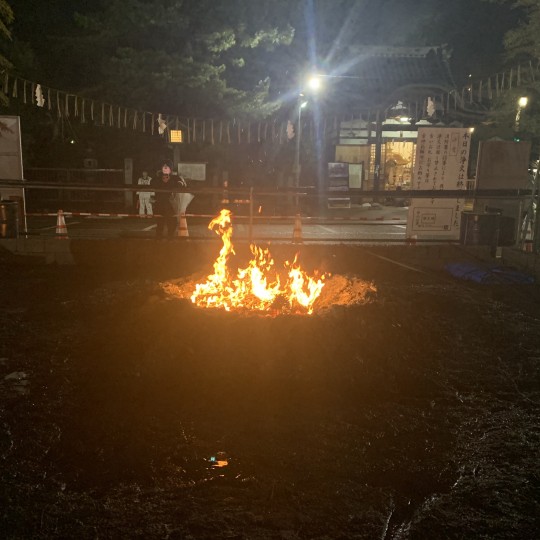
Like most shrines do for New Year's, Hakusan Shrine had rows of food stands set up for people to pass through as they waited to pray. They set up the stands along the walkway into the shrine anytime there’s a big event–including Sakura season in the spring and the wind chime festival in the summer–and New Year’s is certainly a big event in Japan. They usually have all of your typical stands at a Japanese festival–yakisoba, okonomiyaki, takoyaki, fruit candies–in addition to some of Niigata’s specialties, like Poppoyaki, the little pancake sticks they serve at many Niigata festivals.

Then, for the first few days of the New Year, many stores in Bandai City and all around Niigata have the same fun New Year’s sales as stores across Japan. These can range from regular in-store sales for the first few days of the year (usually the 1st through the 3rd or 4th) to specialty bags you can sign up for or buy in stores. These bags, known as Fukubukuro or Lucky Bags, come with a variety of the store’s products and might even include some New Year’s exclusive items. A friend and I split a Lucky Bag from Imayotsukasa Sake Brewery that came with three sake, one of which was only available in the Lucky Bag.
You may have also seen that this year there was a big earthquake near Niigata on January 1st. While this is not typical of New Year's in Niigata, it was an interesting and somewhat frightening way to start this New Year. It was my first big earthquake, so there was a lot of frantic researching, trying to figure out what to do and if I needed to do anything at all other than stay put. Luckily, things turned out alright for me in the end and Niigata City suffered minimal damage, but some of the closer areas are still recovering.

While most New Year’s in Niigata City won’t go off with quite as much of a bang, there’s still plenty to do. Your celebration will certainly look different from New Year’s in the US, but you can drop by a shrine on New Year’s Eve with some friends for food and prayers, then shop until your heart’s content during the sales over the next few days. Overall, not a bad way to start the New Year.
#japan#jet program#niigata#niigata city#edgeofniigata#new year's eve#new year#hakusan shrine#lucky bag
0 notes
Text
Japan's Rivers:
youtube
Japan is an archipelagic country made up of four big islands: Hokkaido, Honshu, Shikoku, and Kyushu, as well as around 6,800 smaller islands. Mountains and valleys dominate the topography, accounting for more than three-quarters of the total land area. Ice and snow from these mountains have formed several rivers, which are vital to the country's transportation, agriculture, and energy generation. Japan's rivers are often short, steep, and fast-flowing. This makes them great hydropower generators, but it also increases the chance of floods. Despite the hazards of flooding, Japanese communities have built near rivers since ancient times. Many of these rivers have been altered, some dramatically, to compensate for this. Under the River Law of 1967, Japan's streams and rivers are classed as Class A or Class B systems. The majority of Japan's most well-known rivers are classified as Class A, indicating that they are economically or ecologically important to the country.

-Waterfall in Yamanashi prefecture, east-central Honshu, Japan.
The growing need for freshwater for paddy (wet-rice) production, industry, and home consumption poses a severe concern. The scarcity of natural water reservoirs, the rapid flow of rivers, and the engineering difficulties of building large-scale dams in the rocky highlands all contribute to supply challenges.

-Ishikari River, western Hokkaido, Japan
Ishikari River in western Hokkaido, Japan. Japan's rivers are usually short and rapid, fed by tiny drainage basins. The major rivers are the Teshio and Ishikari rivers in Hokkaido, the Kitakami, Tone, Shinano, Kiso, and Tenryū rivers on Honshu, and the Chikugo River in Kyushu. Honshu rivers include Tone, Shinano, Kiso, and Tenryū, as well as Kyushu's Chikugo River. Some rivers from northern Honshu's volcanic zones are acidic, rendering them worthless for irrigation and other reasons.

-Ukimi Temple, Lake Biwa, Shiga prefecture, central Honshu, Japan.
Lake Biwa, Japan's biggest, measures 259 square miles (670 square kilometres) in central Honshu. All other large lakes are to the northeast. The majority of coastal lakes, including Honshu's Lakes Kasumi and Hamana, are drowned former valleys with sandbars damming the bay entrances. Honshu's inland lakes, including Biwa, Suwa, and Inawashiro, are located in tectonic depressions formed by geologically recent faults. Volcanic lakes (such as Kutcharo in Hokkaido and Towada and Ashi in Honshu) dominate all others.
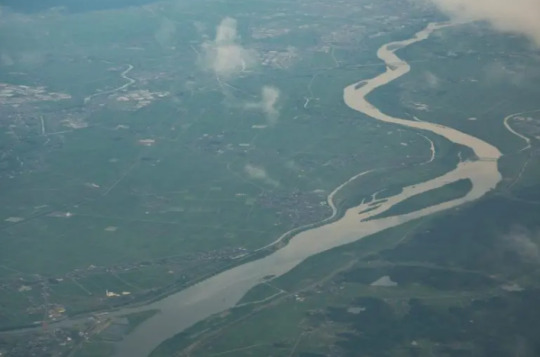
The Shinano River, also known as "Shinanogawa" on the island of Honshu, is the longest river in Japan. The river travels north for about 228 miles, from its source at Mount Kobushi in the Japanese Alps to its mouth in the Sea of Japan. The Shinano River flows through some of the country's most populous areas and major cities, including Matsumoto, Nagano, and Niigata. The Shinano River has played an essential role in Japanese life for millennia. It has functioned as a source of drinking water, a transit route, and a recreational and leisure area. Perhaps its most well-known application is to generate hydroelectric power. Actually, the country's first such power plant, the Miyashiro No. 1 power plant, was built along the river in 1904 and is still operational today. The river supports a rich range of plant and animal species, as well as fish, including Cherry Salmon. The Shinano River is a popular swimming and fishing area in the summer, and an ice skating and fishing destination in the winter. There are also several popular Onsen, or hot springs, along the river.
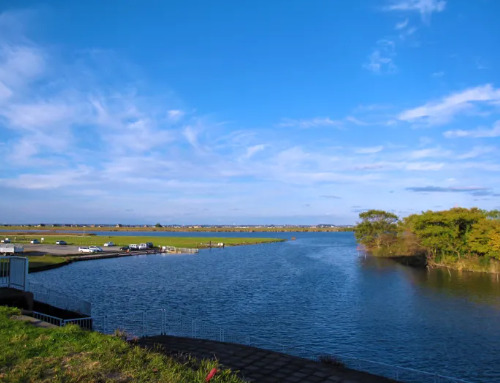
The Tone, or "Tonegawa" River, is one of Japan's most important rivers. This is partly because to its position, running across the densely populated Kanto Plain. The river originates in the mountains of central Japan and flows for approximately 200 miles to the Pacific Ocean. The river's basin, which is the biggest in Japan at 6,540 square miles, is home to nearly 40 million people. This is not just in the country's heart, but also on its greatest plain, which is home to the capital, Tokyo. Tonegawa was formerly a wild and untamed watercourse, but it is now widely regarded as the most intentionally changed of all Japanese rivers. The contemporary path has little similarity to the historic one. Tonegawa now features multiple dams, which serve as reservoirs for the Kanto region's residential and agricultural water needs. The largest of these is the Yagisawa Dam. The river is also utilised for transportation and pleasure, and it is surrounded by Japan's longest car-free cycling trail.

The Teshio, also known as "Teshigahara" in Hokkaido, is Japan's northernmost significant river. It runs for around 159 miles and has a basin area of about 2,160 square miles. The river has an average discharge of around 9,000 cubic feet per second. The Teshio River has been a major commerce and transit waterway since ancient times, and the indigenous Ainu people still utilise it now. The river is an important source of irrigation and hydroelectric power generation.
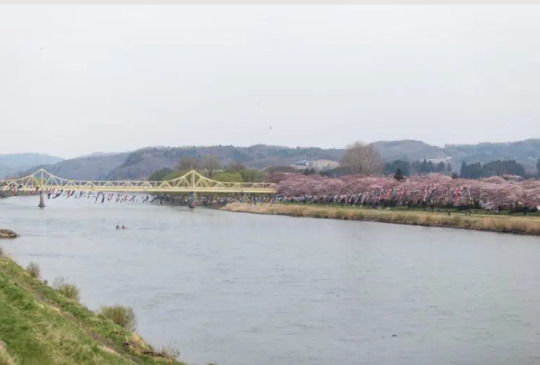
The Kitakami River, which was an important transit route during the Edo era, is the longest river in the Tohoku area, measuring around 155 miles. It is regarded as one of Japan's most picturesque rivers, with an abundance of cherry blossoms in the spring. The Kitakami is also home to a diverse range of fish and is a popular fishing destination.

Located on the island of Shikoku in Kōchi Prefecture, the Niyodo River is famed for its extraordinary turquoise waters. Its source is Mount Ishizuchi and it flows for just 77 miles.
Japan's Rivers:



Havard references:
The Editors of Encyclopaedia Britannica. (1998). Japan's Rivers [Online]. britannica. Last Updated: 27 October 2023.. Available at: https://www.britannica.com/place/Japan/Soils [Accessed 19 February 2024].
discovery uk. (2023). The Best Known Rivers in Japan. [Online]. discovery uk. Last Updated: 12 January 2023. Available at: https://www.discoveryuk.com/travel-and-exploration/the-best-known-rivers-in-japan/ [Accessed 19 February 2024].
0 notes
Text
reuniting with old friends to see more sights in obama and unzen
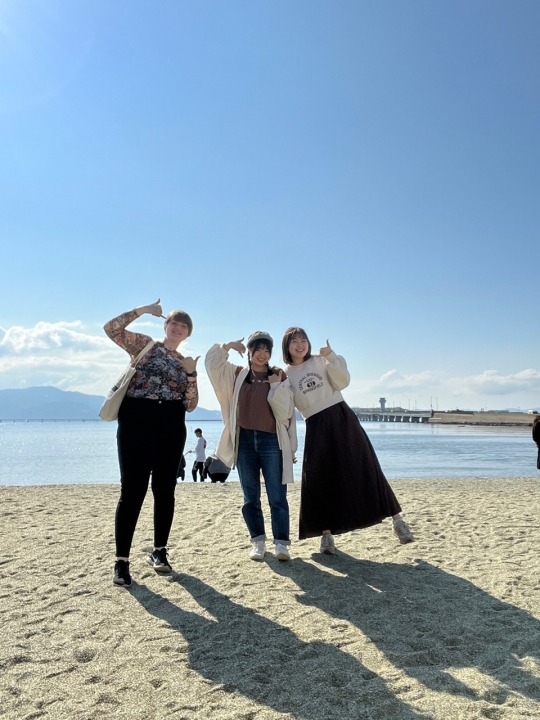
Long time no see! I keep thinking about letting this blog die, but then I think about how happy I’ll be to revisit these memories in detail years from now, and ultimately decide to pick it back up again. The blog is really more of a gift for future me than for other people, but if people enjoy reading it, that makes me happy too. I’m going to pick up here where I left off with events from the fall of last year. Since fall is just beginning again here, some events may overlap, in which case I’ll just be able to cover them for two years in a row. Anyway, let’s get into it!
In November of last year, two high school friends came to visit me in Nagasaki. As some of you may know, I participated in a short high school exhange/host program when I was in high school. For two years in a row I briefly hosted Japanese students at my house and then following high school graduation I was hosted by one of these students in their home during my first trip to Japan. The student that I hosted in 2016 and who hosted me later the same year is named Eri.
Eri now lives in Niigata prefecture in northern Japan where she attends graduate school studying earth science (particularly glaciers, she’s so cool!!) We’ve remained in touch over the years, and we met up once during my study abroad in 2019 in Shiga prefecture. When she learned I would be living in Nagasaki for my teaching program, she promised to come visit me down here as well. She brought along another high school friend, Chihiro, who was on the same exchange program with us, but hosted by a different student. For the memories, here’s a picture of us all in high school on my first trip to Japan!
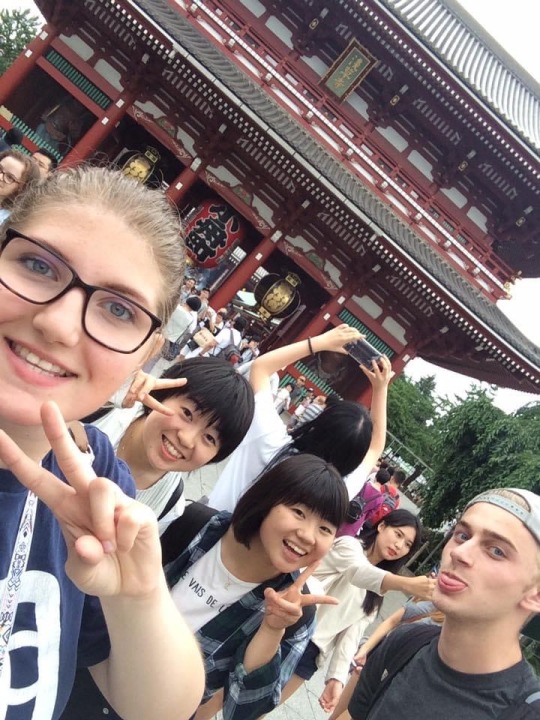
Anyway, Eri and Chihiro came with me to see Omura, Nagasaki city, and the Shimabara peninsula. In the Shimabara peninsula, we visited some places I had not explored yet, including Mt. Unzen and the famous Obama foot bath.
Mt. Unzen is a popular hiking destination and symbol of the Shimabara peninsula. One of my ALT friends even dressed up as the mountain for Halloween. Like me, Eri loves hiking and enjoying nature, but we were a bit short on time, so we decided to take the famous Unzen Ropeway to the top of the mountain instead of hiking.


It was a cloudy day, but the view was still breathtaking, especially when the clouds would move aside for brief moments to reveal the scenery. It was almost more beautiful because the glimpses of scenery were so fleeting, so we treasured them more.
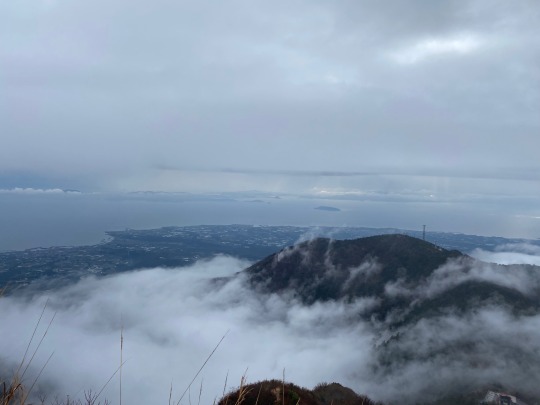


The ropeway station is actually not the top of the mountain, so we climbed the rest of the way to the summit. On the way, there was a small shrine, so we stopped to pray. I pulled a fortune from this shrine and got daikichi, the best luck. This is the first time in my life that I’ve ever pulled the best luck, so it was a special moment for me on this quiet shrine at the top of the mountain.

After exploring Mt. Unzen, we hopped in my car and drove around the peninsula to Obama, a famous hot springs destination. Driving through the town you can see white clouds of steam rising from vents and smell the classic sulphur smell signalling the thermal activity which heats the public baths. I have passed through Obama many times and visited restaurants, shops, and temples there, but had never visited their arguably most famous attraction, Hot Foot 105, proudly claiming to be the longest foot bath in Japan. 105 refers to both the length of the bath at 105 meters, as well as the temperature at 105 degrees celsius.
The bath extends along the coast and you can sit with your feet in the warm water while enjoying the view of the ocean. We arrived there as the sun was setting, which made the view even more spectacular.

At one end of the foot bath, they have various obstacles you can step on to “strengthen” your feet, which usually include evenly spaced rocks and bars. I hate them because they hurt like hell, but many people enjoy walking across them to massage their foot muscles.

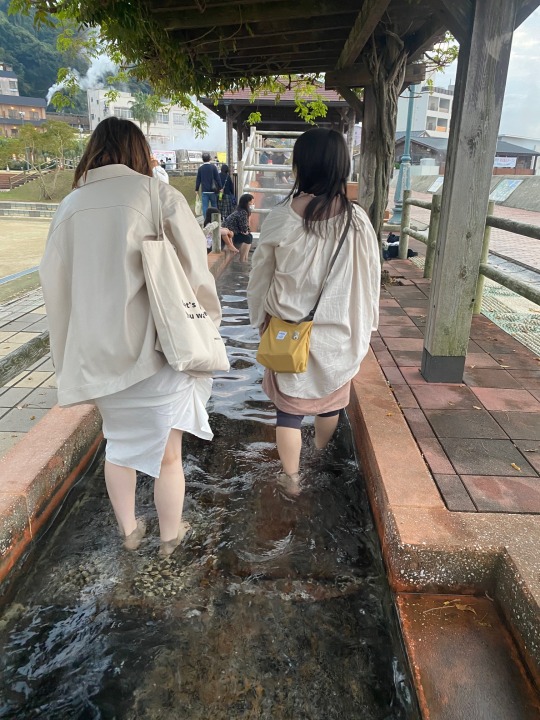
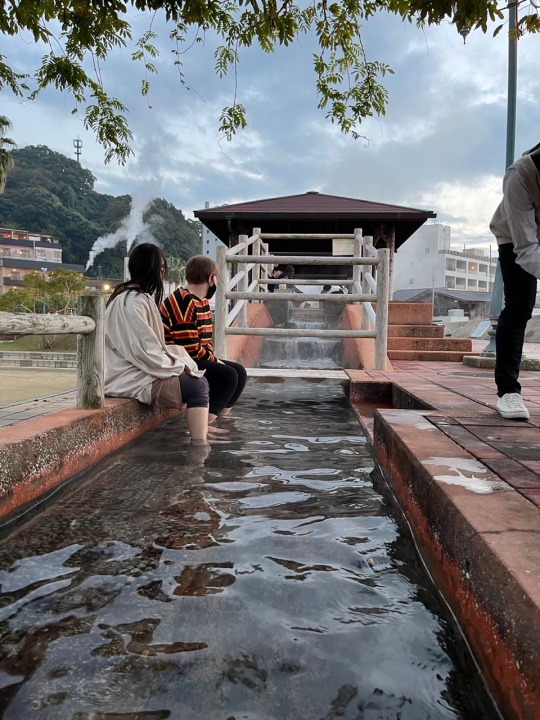
We explored other areas of Nagasaki during my friends’ stay, but I’ve posted about them in detail already, so if you’re interested in learning about those, check out my Nagasaki city, Shimabara, and Nodake Falls posts!


I had a really fun time with Eri and Chihiro and am so grateful for their friendship after all these years. I’m already planning to visit Eri in Niigata and Chihiro where she lives in Yamaguchi prefecture, so I’m looking forward to that. Thanks as always for reading! <3
1 note
·
View note
Text
Skiing Adventure in Japan: Unveiling the Powder Paradise of the Far East
Japan, renowned for its rich cultural heritage, cherry blossoms, and technological marvels, offers much more than meets the eye. Beyond the bustling cityscapes and serene temples lies a hidden winter wonderland that attracts ski enthusiasts from around the globe. Nestled among the majestic mountains, Japan's ski resorts offer an unforgettable skiing adventure like no other. In this article, we will explore the allure of skiing in Japan, the top ski destinations, and why it has become a mecca for powder seekers.
The Allure of Skiing in Japan:
Japan boasts a unique skiing experience, characterized by abundant snowfall, high-quality powder, and the picturesque setting of snow-capped peaks. Unlike many ski destinations around the world, Japan's ski season often starts as early as November and can stretch well into May, offering an extended period for skiing enthusiasts to indulge in their passion. The country's location on the Pacific Ring of Fire and its proximity to Siberia create the ideal conditions for consistent snowfall, referred to as "Japow" – a term coined to describe Japan's legendary powder snow.
Top Ski Destinations in Japan:
Hokkaido: Known as the epicenter of winter sports in Japan, Hokkaido's powder-rich resorts attract skiers and snowboarders from every corner of the globe. Niseko, the most famous of them all, boasts stunning vistas, abundant snowfall, and a vibrant international community. The nearby resorts of Rusutsu and Kiroro also offer fantastic skiing experiences with fewer crowds and equally impressive snow.
Nagano: Home to the 1998 Winter Olympics, Nagano Prefecture is a winter sports paradise. Hakuba Valley is the jewel in its crown, with a collection of ski resorts that cater to all skill levels. The region's magnificent alpine scenery and excellent snow conditions make it a must-visit for skiing enthusiasts.
Tohoku Region: Less frequented by international tourists, the Tohoku region offers a more authentic Japanese skiing experience. Resorts like Appi Kogen and Zao Onsen charm visitors with their cultural richness, hot springs, and challenging slopes.
Niigata: Along the west coast, Niigata Prefecture boasts resorts like Yuzawa and Myoko Kogen. Easily accessible from Tokyo, these areas provide ample opportunities for both beginners and advanced skiers to carve through the powder.
Why Japan is a Mecca for Powder Seekers:
Abundance of Powder: Japan's unique geographical location and climatic conditions create the perfect recipe for consistent, dry powder snow. This "Japow" is a dream come true for powder hounds, providing an unmatched skiing experience.
Culture and Cuisine: Beyond the slopes, skiers in Japan are treated to a captivating cultural experience. From traditional onsen (hot springs) to delectable Japanese cuisine, including fresh seafood and mouthwatering ramen, the skiing adventure extends beyond the snow.
Modern Amenities and Hospitality: Japanese hospitality, or omotenashi, is second to none. Ski resorts in Japan offer modern amenities, top-notch services, and efficient lift systems, ensuring visitors have a seamless and enjoyable experience on and off the slopes.
Unique Terrain: Japan's ski resorts offer diverse terrain, suitable for skiers and snowboarders of all skill levels. Whether you're a beginner seeking gentle slopes or an expert craving challenging steeps, Japan has it all.
FOR MORE INFO:-
Skiing Adventure in Japan
0 notes
Text

Highway Driving to Joetsu in Niigata, Japan
Watch the video:
https://youtu.be/dyi5gUM-IGw
Join me for a scenic drive on a Japanese toll highway towards Joetsu in the southern part of Niigata prefecture, Japan. It's a cloudy day, but some mountains are visible in the distance, and there are lots of rice fields, fun tunnels, and cool overpasses.🚗🌾
Subscribe and follow:
https://www.YouTube.com/@nealgraham
https://www.instagram.com/thenealgraham/
https://www.instagram.com/neal.walks/
2 notes
·
View notes
Text
#日本文化 #日本生活 #文化交流 #文化差異 #生活故事 #台灣人在日本 #文化衝擊 #學習英文 #英語學習 #異國美食
🌸 Greetings from Aizuwakamatsu, Fukushima! Day 17 of my immersive journey across Japan unfolds with bittersweet emotions as I bid farewell to the wonderful memories created with Mr. Star’s family. 🌸
Leaving their warm embrace behind, I eagerly set my sights on the next destination, Niigata prefecture. Excitement courses through my veins, knowing that a vibrant fireworks display awaits and a new and intriguing family eagerly awaits my arrival. Their text messages have been filled with anticipation, promising an unforgettable dinner experience.
This family, with their unique practices and even bugs as pets, captivates my curiosity. I can’t contain my excitement to immerse myself in their world, from indulging in their renowned onsen tofu to savoring the flavors of their Niigata hashidaikon and delectable eggplant dishes.
However, as I sit on the train, the sweltering heat lulls me into a peaceful slumber. With my eyes fluttering open, a surge of concern floods my thoughts. Will I make it to the fireworks and this family Niigata?
Stay tuned, as I navigate through unexpected turns in this journey across Japan!
🌸 福島県会津若松からこんにちは!日本全国を巡る私の旅の17日目が、ミスタースターさんの素敵な家族との思い出に別れを告げると同時に、複雑な感情が心を満たしています。🌸
彼らの温かい抱擁を背に、次なる目的地である新潟県へ向けて心躍ります。生命あふれる花火大会と、新たな興味深い家族の待ち受ける喜びが私を包み込みます。彼らからのテキストメッセージには、忘れられない夕食の体験が期待されています。
この家族はユニークな習慣やペットとしての昆虫を持つことで私の好奇心を惹きつけます。彼らの世界に没頭することに胸が踊ります。名物の温泉豆腐を味わい、新潟のはしだいこんや美味しいナス料理の風味を楽しむことができるのです。
しかし、列車に座っているうちに、酷暑に包まれて平穏な眠りに誘われました。目を開けると、心に懸念の波が押し寄せます。花火大会とこの新潟の家族に間に合うことができるのでしょうか?
続きはお楽しみに!この日本の旅で予期せぬ展開に向かって進みます。
#JourneyAcrossJapan #HeartwarmingConnections #CulinaryExplorations #IntriguingFamilies #UnforgettableMemories #ChasingFireworks #TravelAdventures #UnchartedPaths #StayTunedForUpdates #CliffhangerMoments #日本全国旅行 #心温まる出会い #食文化探求 #興味深い家族 #忘れられない思い出 #花火を追いかけて #旅の冒険 #未知の道 #続報をお楽しみに #クリフハンガーモーメント
#日本文化 #日本生活 #文化交流 #文化差異 #生活故事 #台灣人在日本 #文化衝擊 #學習英文 #英語學習 #異國美食 published first on https://www.youtube.com/@revywild
0 notes
Text
What airport is the closest to Nozawa Onsen?
Planning to carve out some memorable moments in Japan? Search for Nozawa Onsen Guide.
Nozawa Onsen is a scenic mountain village in the Nagano Prefecture. The tiny laid-back town attracts tourists from across the globe for being one of the most beautiful skiing resorts in Japan. Although it is a popular skiing destination, the picturesque location doesn’t cease to amaze even in the green season. Whether you are up for an adventurous holiday in powder snow or looking for some quality time amidst Mother Nature, Nozawa certainly tops the Japan onsen guide.
Where is Nozawa Onsen located?
Nozawa Onsen is a mountain village located in the Shimotakai district of the Nagano prefecture in Japan. It is merely an hour’s drive away from Nagano city. The charming village is nestled at the foothills of Kenashiyama Mountain. It is located in the Kogen National park and the altitude here falls between 300 meters and 1650 meters above sea level. Surrounded by forests and greenery as well as powder snow, Nozawa Onsen has an abundance of natural beauty.
How to reach Nozawa Onsen?
Nozawa Onsen is a renowned skiing destination in Japan, therefore it is well connected with the rest of the country. The best way to reach Nozawa is to fly to Tokyo and then take the Nozawa onsen shuttle service.Alternatives to the shuttle bus service are train rides or private airport transfers.
Tokyo Haneda is a popular choice for tourists who are flying to Nozawa Onsen. However, there are plenty of other options, such as Matsumoto, which is the closest airport to Nozawa Onsen and Komatsu which is known for being the cheapest of all. Another alternative is the Niigata airport which is only 127 kilometers away from Nakano city.
What is Nozawa Onsen famous for?
Nozawa Onsen is a charming hot spring village which attracts skiing enthusiasts from across the globe. The Nozawa Onsen Ski Map shows that the slopes here are suitable for everyone including amateurs and expert skiers. Apart from the 297 hectares wide modern ski resort, Nozawa Onsen is renowned for the following:
Hot springs: Nozawa Onsen is an ancient village dating back to the 8th It is renowned for the mesmerizing 30 natural hot springs. There are plenty of public bathhouses in this village that have become tourist attractions.
Fire festival: Another way to get up close cultural encounters is the fire festival of Nozawa Onsen. The annual festival is counted amongst the biggest fire festivals in Japan. It is a celebratory event that includes lit up torches, a sacred shrine and locals dancing in ethnic attires.
Japan ski museum: Want to explore what the early days of skiing look like in Japan? Don’t forget to visit the Japan Ski Museum in Nozawa Onsen. It offers a
Rich Japanese culture: The onsen village has become the top choice for tourists because of the ample cultural dose they get in this quaint town. Tourists can take part in lots of local events throughout the year and take memories back home.
Authentic cuisine: Nozawa Onsen is also popular among foodies. Myriads of bars, restaurants, teppanyaki restaurants and cafes won’t disappoint a foodie searching for authentic Japanese cuisine. Simply take the Nozawa Onsen Liner Bus and explore the city at your own pace.
Green season: Nozawa Onsen has the most beautiful and most advanced ski resort but that doesn’t mean there is nothing to do in the green season. Tourists can explore the surroundings by hiking and trekking and also experience an adrenaline rush with mountain biking. The trails are suitable for every age group and offer great activities in the green season.
Where to stay in Nozawa Onsen?
Nozawa Onsen is a fun and affordable destination that welcomes tourists from every age group and budget bracket. Here you get affordable hotels and hostels that are perfect for solo travelers and students. Besides, large groups and families seeking privacy and a lot of amenities can opt for cabins or luxury apartments.
The most popular accommodation choices for a time of life in Nozawa Onsen are Dennojo, Kamoshika Ski Lodge, Iroha Nozawa, Schneider Hotel, Oguma House and Tanuki Nozawa. You can make reservations at any of these properties with the help of a local touring agency. These service providers can help you sort everything related to your time in Nozawa Onsen at the best deals. You get amazing offers on accommodation as well as make arrangements for travel, ski rentals, lift tickets, lessons and more at Nozawa Onsen.
Closing thoughts
Nozawa Onsen is a well-connected town and there are plenty of options to get there. Visit Stay Nozawa to sort your travel arrangements as they are renowned for their associations with local businesses. Connect with the team of Stay Nozawa right now and get an additional 20% discount on accommodation.
0 notes
Text
Climbing the Hundred Famous Mountains in Japan
Listed in the 100 Famous Mountains in Japan is Mt. Mizugaki in Yamanashi Prefecture in the Chubu Region. The mountain was once called the "Queen of the Southern Alps" because of its beauty. This mountain is relatively safe to climb and has some great views from its summit. One hundred of Japan's most famous mountains, KaiKomagatake is located in the north-central part of the Akaishi Mountains and is a pyramid-shaped mountain covered with granite. Its name suggests its prominence from afar, and you can't miss it.
Mount Omine, also known as Mount Sanjo, is a sacred mountain in the Xiu Yan Dao Shugendo syncretic religious movement. It was inhabited by Shan bushiyamabushi during the medieval period, who achieved spiritual purification on this mountain. This mountain is now more of a spiritual destination than a tourist attraction. However, you may need to speak Japanese to be able to understand the language of a yamabushi, the local mountain guides who provide tours to the peak. You can find more information about 山登り
Another famous mountain is Kusatsu in the northern Alps. It is the first big mountain of the famed ridge run. You can access the summit from the marshes or from a year-round snowfield. There are alpine onsen and a spectacular gorge that encircles the mountain. You can find many hiking trails that go down from the mountain to the surrounding hill country. There are also giant huts located close to the summit that offer a view of the region.
A list of Japan's Hundred Famous Mountains can be lengthy and complicated, but it's well worth reading. Fukuda's list is both short and informative, focusing on the histories of the mountains and the meaning behind their names. The book also features a list of lesser-known mountains in Japan, such as Mount Asama in Ise, Mount Nokogiri on the Boso Peninsula, and other small but significant peaks.
Another mountain that makes the list of the Hundred Famous Mountains in Japan is Mt. Myoko, which is 2,400 meters high. It is part of the Kubiki Sanzan, a group of three mountains in Niigata Prefecture. Koyaike is the northernmost of these mountains and is known for its changing vegetation throughout the seasons. It is also home to the northernmost rock ptarmigan colony.
The name of Mount Fuji is not clear, but its origin is in doubt. First recorded in a 713 ce government record, it is believed to be an amalgam of Ainu word "fire" and the Japanese word for "mountain". The kanji used in writing Fuji connotes good luck and a wealth of prosperity. Today, foreign tourists commonly refer to Mount Fujiyama, which translates to "Mount Fuji mountain".
Tochimoto, which is located at the intersection of Shinshu and Chichibu roads, is an enchanting mountain town. The town has a checkpoint for vehicles when traffic is heavy. Among the top attractions are Mt. Mitake and Mt. Mitsumine, which were once used as training grounds for Buddhist priests. You can also visit the Musashi-Mitake-jinja Shrine, a traditional mountain shrine. Both have a solem atmosphere and are surrounded by sacred trees and temple lodges.
1 note
·
View note
Text
Top 5 Japanese Vacation Locations
There are 14 subprefectures in Hokkaido and Kamikawa is definitely arguably the very best sub-prefecture in terms involving popularity among Japan tourists. This element of Japan still retains its Japanese charm. The very best several weeks to come upward this way is in This summer and August, or perhaps even in September. Winter is ok too for anyone who is experience a bit brave and can manage driving on unmarked icy roads together with almost zero presence through your windshield owing to sporadic snowstorms. On my very last trip up, I actually stayed at a place called Ryounnkaku, a hot spring hotel that folks travel from the significantly to experience. It is the kind of sizzling spa that 1 must sit within to appreciate the particular natural surroundings of snow-covered mountains highs.
I have sat with night in a start air bath inside the middle of a snowstorm! kamaboko food don't declare lightly nor must i state it with all the minimum bit of hyperbole, but a reality. I got sitting inside an open atmosphere hot spring health spa in the midsection of a night-time snowstorm to the particular point that I had to wrap my personal face in buy to breathe. No picture was feasible at that moment. Yes. For us this was a holiday of a life time. Where else inside of the world can you go and perform this type of thing?
Nara, our house were impressive. Not any trip to Land der aufgehenden sonne (umgangssprachlich) will be complete until Nara was in your itinerary. The importance of Nara, being the former capital of Japan, is fundamentally one particular of the almost all important centers associated with Japanese culture plus religion. Here in Nara you can find first hand the fusion between two extremely old and venerated religions; Buddhism and Shintoism, the previous getting from away from The japanese, and the last mentioned being of Japan origin. Evidence associated with this union can be found when visiting the temples in and around Nara, where 1 can immediately sees Shinto Shrines on the same environment as temples. Merely travelling Nara, one particular can have a perception of reverence in addition to the timeless beauty of centuries of Western history and lifestyle.
Hakone, a town known mainly for its natural warm spas and lovely scenery, is home to Lake Ashinoko and even Japanese fish muffins. Old Timers specially enjoy stopping by means of here to relive a period when presently there was no tourism. They also create trips here to take pleasure from sweet bean buttocks and fish muffins. The thing I actually like about Hakone is that nevertheless many tourists go here, the town has not was a victim of the ubiquitous tourist barriers found in numerous major vacation areas like Hawaii plus Thailand. You no longer see shop proprietors trying for power their products to you, and haggling is almost unheard of down here. I hope it remains that method. That's probably precisely why I keep coming back again there and exactly why I chose it since a top escape spot.
Niigata, You may or may not have had some sort of chance to see the rugged backbone regarding Minakami, nor the sweetness scattered about typically the northwestern corner regarding the Kanto Region. And you may well have never heard regarding little off the defeated track stations want JR Yubiko subway tunnel station. Probably time is funds for you. Although some say the indicates you determine to get to be able to your destination is certainly not important, which getting there as soon as possible is the best method to complete out and about of your trip, I say, no. I totally disagree. Just how you arrive at your destination is just as a lot a part of your vacation while being at the desired destination. I had assured myself years before that I would attempt this kind of epic 7 hours journey across several of Japan's most pristine backcountry. Convey trains can get to this area in 2 hours and 35 minutes. Here you are at the particular real Japan.
Aomori, Shirakami is an enormously densely wooded area straddling each Aomori and Akita Prefectures in upper Japan on typically the Sea of Okazaki, japan side in the Tohoku Region. The do itself have been acclaimed as a pristine virgin beech woodland preserve. What which means is, for the almost all part, is the fact that is actually untouched by deforestation and heavy structure projects, which is, using the exception regarding a few pavement and interchanges regarding accessibility, the complete forest has unspoiled beauty untouched simply by the scars regarding modern infrastructures and super highways. The virgin beech forest is an UNESCO World Heritage Internet site, home to 100s if thousands involving rare species; one that comes to be able to mind is the black woodpecker, a lovely much larger than average woodpecker found mainly during northern Europe and Shirakami. It's exceptional to see this type of woodpecker in other parts of Japan. Typically the best seasons to see are summer and fall months.
1 note
·
View note